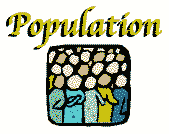|
|
|
|
|
|
|

| Togo's population is composed of about 21 ethnic groups. The two major groups are the Ewe in the South and the Kabye in the North. Population distribution is very uneven due to soil and terrain variations. The population is generally concentrated in the south and along the major north-south highway connecting the coast to the Sahel. Age distribution is also uneven; more than one-half of the Togolese are less than 15 years of age. The ethnic groups of the coastal region, particularly the Ewes (about 25% of the population), constitute the bulk of the civil servants, professionals, and merchants, due in part to the former colonial administrations which provided greater infrastructure development in the south. The Kabye (15% of the population) live on submarginal land and traditionally have emigrated south from their home area in the Kara region to seek employment. Their historical means of social advancement has been through the military and law enforcement forces, and they continue to dominate these services. |
| POPULATION GRAPH |
 |
| 6,031,808 country comparison to the world: 105 note: estimates for this country explicitly take into account the effects of excess mortality due to AIDS; this can result in lower life expectancy, higher infant mortality, higher death rates, lower population growth rates, and changes in the distribution of population by age and sex than would otherwise be expected (July 2009 est.) Age structure: 0-14 years: 41.4% (male 1,252,389/female 1,244,914) 15-64 years: 55.8% (male 1,645,885/female 1,719,810) 65 years and over: 2.8% (male 66,192/female 102,618) (2009 est.) Median age: total: 18.7 years male: 18.3 years female: 19.2 years (2009 est.) Population growth rate: 2.754% (2009 est.) country comparison to the world: 20 Birth rate: 36.49 births/1,000 population (2009 est.) country comparison to the world: 31 Death rate: 8.95 deaths/1,000 population (July 2009 est.) country comparison to the world: 81 Net migration rate: NA (2009 est.) Urbanization: urban population: 42% of total population (2008) rate of urbanization: 4.3% annual rate of change (2005-10 est.) Sex ratio: at birth: 1.03 male(s)/female under 15 years: 1.01 male(s)/female 15-64 years: 0.96 male(s)/female 65 years and over: 0.65 male(s)/female total population: 0.97 male(s)/female (2009 est.) Infant mortality rate: total: 56.84 deaths/1,000 live births country comparison to the world: 42 male: 63.97 deaths/1,000 live births female: 49.49 deaths/1,000 live births (2009 est.) Life expectancy at birth: total population: 59.66 years country comparison to the world: 186 male: 57.4 years female: 61.99 years (2009 est.) Total fertility rate: 4.79 children born/woman (2009 est.) country comparison to the world: 33 HIV/AIDS - adult prevalence rate: 3.3% (2007 est.) country comparison to the world: 21 HIV/AIDS - people living with HIV/AIDS: 130,000 (2007 est.) country comparison to the world: 40 HIV/AIDS - deaths: 9,100 (2007 est.) country comparison to the world: 35 Major infectious diseases: degree of risk: very high food or waterborne diseases: bacterial and protozoal diarrhea, hepatitis A, and typhoid fever vectorborne diseases: malaria and yellow fever water contact disease: schistosomiasis respiratory disease: meningococcal meningitis animal contact disease: rabies note: highly pathogenic H5N1 avian influenza has been identified in this country; it poses a negligible risk with extremely rare cases possible among US citizens who have close contact with birds (2009) Nationality: noun: Togolese (singular and plural) adjective: Togolese Ethnic groups: African (37 tribes; largest and most important are Ewe, Mina, and Kabre) 99%, European and Syrian-Lebanese less than 1% Religions: Christian 29%, Muslim 20%, indigenous beliefs 51% Languages: French (official and the language of commerce), Ewe and Mina (the two major African languages in the south), Kabye (sometimes spelled Kabiye) and Dagomba (the two major African languages in the north) Literacy: definition: age 15 and over can read and write total population: 60.9% male: 75.4% female: 46.9% (2003 est.) School life expectancy (primary to tertiary education): total: 9 years male: 11 years female: 7 years (2000) Education expenditures: 2.6% of GDP (2002) country comparison to the world: 156 |


